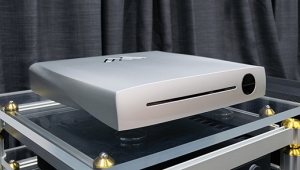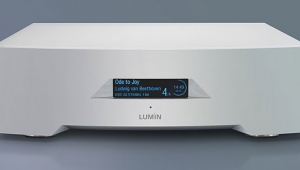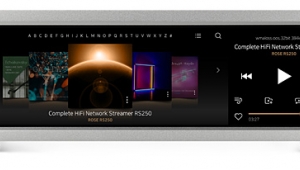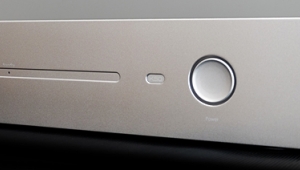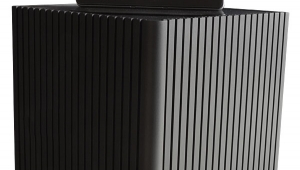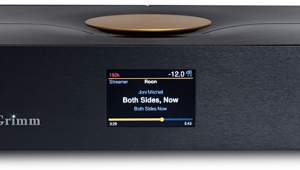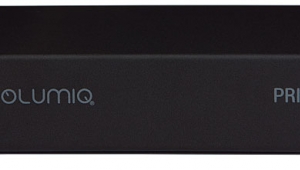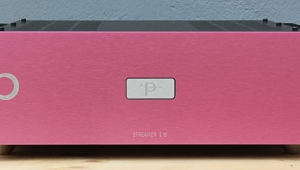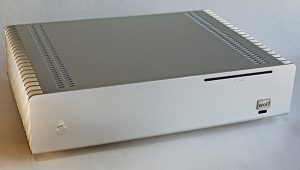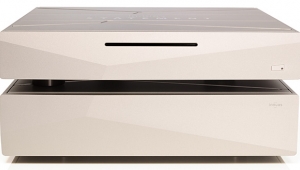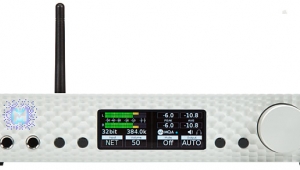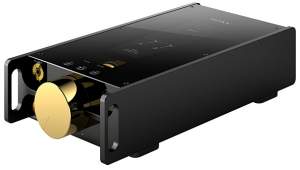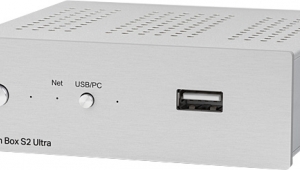| Columns Retired Columns & Blogs |
Roku SoundBridge M1001 network music player Measurements
Sidebar 3: Measurements
To measure the Roku SoundBridge M1001, my original plan was to use it to access the uncompressed test-tone data files residing in the iTunes library on the Mac mini that acts as my household music server. Unfortunately, while the Roku recognized the existence of both the library and the SlimServer software that feeds the library to my Squeezebox, I kept getting a "Server Not Responding" error message when I tried to browse that library. I checked that the Mac's Network, Firewall, and Music Sharing settings were correct, but to no avail, so I ended up installing iTunes for Windows on my test lab's PC and using that, which the SoundBridge had no problem accessing.
The Roku's analog output level into 100k ohms with its volume control set to "100%" was 813mV RMS, which is a little lower than the 1V (2.83V peak–peak) specified. The player did preserve absolute polarity; ie, was non-inverting. The output impedance at midrange and high frequencies was relatively high, at 1k ohm. This in itself will not lead to problems. However, the impedance rose to an extreme 11k ohms at 20Hz, meaning that the Roku's bass will sound rolled-off from its analog output unless it is used with a preamp having an unusually high input impedance of 100k ohms or more. Even though there is still a slight low-bass rolloff into 100k ohms, of –1dB at 18Hz (fig.1), this probably won't be audible. Of more interest in this graph is the slight response ripple evident in the midrange and treble, which implies that the SoundBridge uses a rather old-fashioned digital filter. Channel separation (fig.2) was better than 85dB in both directions below 1kHz, but decreased to 60dB at 20kHz, which is still adequate.

Fig.1 Roku SoundBridge M1001, frequency response at –12dBFS into 100k ohms (right channel dashed, 0.5dB/vertical div.).

Fig.2 Roku SoundBridge M1001, channel separation (10dB/vertical div.).
My primary test to examine a DAC's resolution is to sweep a 1/3-octave bandpass filter down from 20kHz to 20Hz while the DAC decodes data representing a dithered 1kHz tone at –90dBFS. I initially had a problem in that the SoundBridge seemed very sensitive to picking up hum fields from other audio components. I had to place it well away from everything else in order to be sure that the results I measured from its analog outputs truly reflected its intrinsic performance. That performance was puzzling: the 1kHz tone was reproduced with a large positive error and a significant amount of second-harmonic content (fig.3). The noise floor is also much higher in level than is usually found with 16-bit audio data. This is very poor behavior. There is a slight peak evident at 60Hz in this graph. Repeating the spectral analysis but with data representing digital black gave the pair of traces shown in fig.4: while the noisefloor is lower in level than in fig.3, power-supply–related peaks can be seen at 60Hz and 180Hz, and another peak of unknown origin is evident just below 60kHz.

Fig.3 Roku SoundBridge M1001, 1/3-octave spectrum with noise and spuriae of dithered 1kHz tone at –90dBFS, 16-bit data (right channel dashed).

Fig.4 Roku SoundBridge M1001, 1/3-octave spectrum with noise and spuriae of digital black, 16-bit data (right channel dashed).
Tying in with the amplitude error in fig.3, the Roku's plot of linearity error against absolute signal level is very poor (fig.5). Not only do signals below –78dBFS suffer an increasingly positive error, the DAC is "deaf" to signals with a level of –75dBFS, hence the notch in the linearity error trace at that level. Probably what is happening is that a DAC code error is leading to frequency doubling at that level, minimizing the fundamental's energy in favor of the second harmonic. (I had already returned the SoundBridge to Larry Greenhill when I analyzed these test data, otherwise I would have run more tests to confirm this conjecture. I will do so in a Follow-Up.) Because of the linearity error, the SoundBridge's reproduction of an undithered 1kHz tone at exactly –90.31dBFS reproduces at a higher level than expected, but with what should be just three clearly delineated DC voltage levels overlaid by noise (fig.6).

Fig.5 Roku SoundBridge M1001, left-channel departure from linearity, 16-bit data (2dB/vertical div.).

Fig.6 Roku SoundBridge M1001, waveform of undithered 1kHz sinewave at –90.31dBFS, 16-bit data.
Tested for conventional harmonic distortion, the SoundBridge produced reasonably low levels of spuriae. Fig.7 was taken with the Roku decoding data representing a full-scale 1kHz tone into a fairly low impedance of 8k ohms. The volume control was set to "88%" (–7dB) for this measurement, because I wanted to make sure I was not overdriving the unit's output. The THD was a very low 0.006% from both channels, with the third harmonic the highest in level at –85dB. But note the picket fence of spurious tones in the Roku's output. Yes, these are all almost 100dB below the level of the signal, but they shouldn't be there at all. Suspecting that the volume control was to blame, I repeated the test with it set to "100%," but other than the increase in volume, the result was identical.

Fig.7 Roku SoundBridge M1001, spectrum of 1kHz sinewave at 0dBFS into 8k ohms, volume control at "88%" (–7dB) (linear frequency scale).
The SoundBridge's analog output was less well behaved at low frequencies: even into 100k ohms, a full-scale 50Hz tone was accompanied by the second harmonic at –62dB and the third at –74dB (fig.8). The distortion components rose considerably with the SoundBridge driving a low 600-ohm load (not shown). This player is not comfortable driving low frequencies into impedances much below 10k ohms, in my opinion.

Fig.8 Roku SoundBridge M1001, spectrum of 50Hz sinewave at 0dBFS into 100k ohms, volume control at "100%" (linear frequency scale).
Intermodulation distortion with an equal mix of 19kHz and 20kHz tones was respectably low (fig.9), but again, the noise floor in this graph is obscured by spurious tones. Finally, when tested for its rejection of word-clock jitter on the incoming audio data using the Miller Jitter Analyzer, the SoundBridge produced a very high 3 nanoseconds peak–peak of jitter. Fig.10 is a narrowband spectrum of the DAC's analog output while it decoded 44.1kHz data representing a high-level tone at exactly one-quarter the sample rate, over which had been laid the LSB toggling on and off at exactly 1/192 the sample rate. Data-related sidebands are absent, but: the noise floor is 15dB higher than with the best 16-bit DACs I have measured; the central peak representing the 11.025kHz tone is broadened at its base, presumably due to low-frequency random jitter; and a plethora of sidebands can be seen, either power-supply–related (brown numeric markers) or of unknown origin (purple).

Fig.9 Roku SoundBridge M1001, HF intermodulation spectrum, 19+20kHz at 0dBFS peak into 8k ohms, volume control at "100%" (linear frequency scale).

Fig.10 Roku SoundBridge M1001, high-resolution jitter spectrum of analog output signal (11.025kHz at –6dBFS, sampled at 44.1kHz with LSB toggled at 229Hz), 16-bit CD data. Center frequency of trace, 11.025kHz; frequency range, ±3.5kHz.
LG did note that he was not impressed by the sound of the Roku SoundBridge's analog outputs, and so ended up using its S/PDIF output to feed digital audio data to an outboard D/A processor, which should have bypassed all the problems with the implementation of the SoundBridge's analog circuitry. To check that this was indeed the case, I connected first its TosLink output, then its coaxial digital output to the Musical Fidelity X-24K that serves as my test lab's utility DAC. The X-24K has excellent jitter rejection, producing just 240 picoseconds peak–peak when fed from the soundcard in my PC by a TosLink connection. However, the TosLink connection from the Roku gave a high 2083ps of jitter (2.08ns) in the Musical Fidelity's output, with the spectral analysis (fig.11) indicating a series of sidebands spaced at 150Hz and its harmonics to the sides of the spectral line representing the 11.025kHz tone. Note also the regular series of spurious tones in this graph, indicated with green numeric markers and all between –92dB and –95dB. I have no idea what these might be due to—they are certainly not jitter-related.

Fig.11 Musical Fidelity X-24K, high-resolution jitter spectrum of analog output signal (11.025kHz at –6dBFS, sampled at 44.1kHz with LSB toggled at 229Hz), 16-bit CD data sourced from Roku SoundBridge via TosLink connection. Center frequency of trace, 11.025kHz; frequency range, ±3.5kHz.
I did some Googling online to see if anyone had noted anything similar. I didn't find any such comments, but what I did find was some discussion on the Roku Web forum about the fact that the SoundBridge converts the sample rate of incoming data to 48kHz before presenting it to the internal DAC and the S/PDIF digital output. I checked the X-24K's sample-rate indicator when it was supposedly being fed 44.1kHz-sampled, CD-derived data by the SoundBridge: "48kHz"!
A Roku spokesperson on the Web forum stated that though this design decision "makes passing 44.1kHz sources through untouched impossible...we've used a very high quality sample-scaling routine in an effort to make the resampling as good as possible and it should be inaudible." Yes, the SoundBridge does use Analog Devices' respected Blackfin DSP chip, but my experience has been that converting data with a sampling rate of 44.1kHz to one with a 48kHz rate is difficult to do with sufficient precision. It looks as if the Roku's automatic but, in my opinion, unnecessary conversion to 48kHz compromises the audio data's noise floor by introducing mathematical artifacts that I would be surprised wouldn't be audible. Add that corruption of its digital output to its underperforming DAC and analog circuitry, and you can see why I was disappointed by the Roku SoundBridge M1001. It actually measures worse than the DAC in the cheaper Apple Airport Express WiFi base station, let alone that in the more expensive Slim Devices Squeezebox. Very disappointing.—John Atkinson
- Log in or register to post comments
